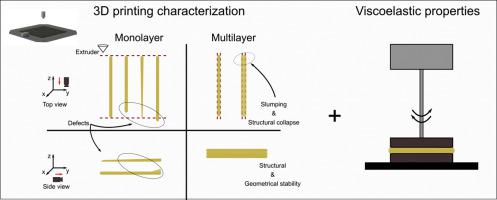Innovative Food Science & Emerging Technologies ( IF 6.3 ) Pub Date : 2020-05-19 , DOI: 10.1016/j.ifset.2020.102384 Ahmed Raouf Fahmy , Thomas Becker , Mario Jekle

|
Structural control over cereals' crumb matrix is achievable using 3D printing. The manipulation of the cellular structure including void fraction, pore size, geometry, and distribution is achievable by resolving large structures into finite layers. However, investigating the applicability of material extrusion for printing starch and cereal-based systems is of great interest due to the behavior of the thixotropic and pseudoplastic materials during extrusion and their viscoelastic post-printing geometric response. In this study, we use an on-board camera system composed of top- and side-view cameras to characterize the post-printing geometrical attributes of two cereal-based systems, which comprise of wheat flour dough and wheat starch-egg white protein blends. This quantitative method uses image processing techniques to obtain morphological dimensional parameters. Furthermore, the induced defects involving printing delays and under-extrusion are influenced by the material's yielding behavior. Over-extrusion defects are dominant in printing wheat flour dough due to the network formation of gluten which caused the collapse of the uppermost layer. Moreover, the structural collapse behavior for the printing ink systems is obtained concerning the hydration level of the dry components. For the first time, the quality behaviors and dimensional attributes were quantitatively studied using on-board imaging and analysis of 3D printed cereal-based morphologies.
中文翻译:

谷物基材料的3D打印和增材制造:使用基于相机的形态学方法对淀粉基系统进行质量分析
使用3D打印可以对谷物的碎屑基质进行结构控制。通过将大型结构解析为有限的层,可以实现对细胞结构的控制,包括孔隙率,孔径,几何形状和分布。然而,由于在挤出过程中触变和假塑性材料的行为及其粘弹性的印刷后几何响应,研究材料挤出在印刷淀粉和谷物基体系中的适用性引起了极大的兴趣。在这项研究中,我们使用由顶视和侧视摄像头组成的车载摄像头系统来表征两种基于谷物的系统(包括小麦面粉面团和小麦淀粉-鸡蛋白蛋白混合物)的印刷后几何属性。 。这种定量方法使用图像处理技术来获得形态学尺寸参数。此外,涉及印刷延迟和挤出不足的诱发缺陷受材料屈服行为的影响。由于面筋的网络形成导致最上层的塌陷,在挤出小麦粉面团中过度挤出缺陷占主导。此外,关于干燥组分的水合程度,获得了印刷油墨系统的结构塌陷行为。首次使用车载成像和基于3D打印谷物的形态分析对质量行为和尺寸属性进行了定量研究。屈服行为。由于面筋的网络形成导致最上层的塌陷,在挤出小麦粉面团中过度挤出缺陷占主导。此外,关于干燥组分的水合程度,获得了印刷油墨系统的结构塌陷行为。首次使用车载成像和基于3D打印谷物的形态分析对质量行为和尺寸属性进行了定量研究。屈服行为。由于面筋的网络形成导致最上层的塌陷,在挤出小麦粉面团中过度挤出缺陷占主导。此外,关于干燥组分的水合程度,获得了印刷油墨系统的结构塌陷行为。首次使用车载成像和基于3D打印谷物的形态分析对质量行为和尺寸属性进行了定量研究。











































 京公网安备 11010802027423号
京公网安备 11010802027423号